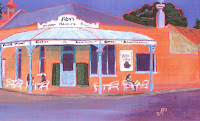
One of the pleasures of retirement is making new friendships. In 2001, I met Bill Heywood, a man my own age who was then living in a local nursing home as the result of a stroke.
In the four years that followed, Bill told me some wonderful, enriching and often humorous stories from his extraordinary life.
Here is one of them. More will follow in the weeks ahead.
A LIBERATING QUESTION
“You can’t read, can you?”
Bill Heywood, 15 years old, blushed, gulped and made the big
decision to own up, not an easy choice after all those years of avoidance and frustration.
The place was a logging camp at Murrindindi in the Victorian State Forest near Toolangi. The questioner was Les Fuller, a middle-aged Scottish migrant who was working at the camp because his broad accent had prevented him from getting a teaching job in Victoria.
Les Fuller was right. He had been observing Bill in the Mess each
day when the other fellows talked and browsed through the papers
and magazines that littered the big table. His years of teaching and a certain intuitive sense had led him to ask the memorable question.
“ Would you like me to teach you?”
“I sure would,” Bill replied with a surge of relief.
In describing the experience at Murrindindi, Bill recalls:
“What an offer! Soon we were right into it. Les had a lot of reading books from his teaching days, and I was soon on the way. There wasn’t much reading material available, so I would grab the tins and packets in the cookhouse and practise by reading the labels and instructions on them. The cook wasn’t too pleased but I didn’t care because I was making so much progress. All because Les Fuller had taken the risk of asking that question.”
How had an intelligent, sensitive man, now living in a Brunswick nursing home after a stroke, managed to spend eight years in inner city state schools in the 1950’s without learning to read?
When I asked him recently, Bill replied, “I was a left hander,
and when I was trying to write in the early grades my hand used
to smudge the writing and they told me I had to write with my
right hand. They even tied my left hand to my braces so I couldn’t
use it.”
That’s how it all began. The classes were large. Bill never got hold of the basic skills of reading and writing. Timid, negative and unobtrusive, he developed ways of covering up his handicap, moving from grade to grade without any remedial help. As the classroom provided little pleasure and much fear of detection, Bill became a frequent truant.
He told me recently, “ I would often wag it. One of my mates would say to me, ‘I reckon the flathead will be biting today, Bill’, and we would take the day off. We used to run down to Johnston Street where we’d catch the bus to Garden City and then walk across to Station Pier where we would throw our lines into Port Philip Bay. ”
Bill never truanted on Fridays - when they had sport - or on Tuesdays - when the boys did woodwork and the girlscooked. At the end of the day, the boys had to eat what the girls had made. “Sometimes it tasted O.K., but sometimes…!”
That was 50 years ago
Today, Bill Heywood successfully tackles the Herald Sun
crosswords and he regularly wins games of Scrabble.
The Fitzroy and Carlton libraries hold copies of his book
THE NEWRY STREET NEIGHBOURHOOD in which he
describes many colourful incidents in a full and satisfying life.
His enthusiasm for the Brisbane Lions and his total antipathy
to the Magpies ensure that his encounters with staff in the nursing home are always lively.
It’s one thing to learn to read but it’s something else to become an expert in doing crosswords. How did Bill go on to develop this extraordinary skill, undiminished by the stroke that has landed him
in a local nursing home?
That is another story waiting to be told.
Mac Nicoll

















